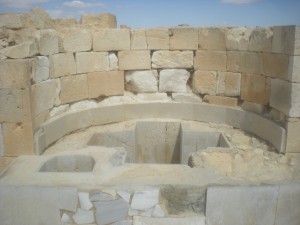
I guess I knew that last week’s photo would be a bit more challenging, but I really liked the guesses people made in the comments. All were very logical, and show that we can tell a lot about this country by making informed guesses.
By the way, it also raises another point. Yes, I post these pictures as a fun little game for you all to see if you can recognize the pictures’ subjects. But in my interactions with you all I’ve heard a bit of hesitance to guess if you don’t know the correct answer. That’s not really my point with these. Rather, the real point of these posts is the blog post I write each week in which I talk about the correct answer. The picture is not the important thing; the explanation of it is. These photos are a brief way for me to launch discussion of the various sites (and sights) around this awesome country of Israel. So please do leave your guesses in the comments about this week’s mystery photo, above.
In this past week’s case, four people left comments (and one answered me in person). The only truly correct answer was by Alexandra (the Crazy Sexy Fun Traveler), since she wrote “Nice place!” That it is indeed, but I unfortunately can’t give credit for that response! In fact, the correct response was the old railway station at Kfar Yehoshua in the Jezreel Valley. First I will tell you a little about the railway and then I will tell you why the guesses were good ones.
Remember, for starters, that today’s State of Israel was a small part of the much larger Ottoman Empire from 1516 to 1917. And being a Muslim empire, the Ottomans had a logical desire to improve the connection of their capital in Istanbul with their holy city in Mecca. Istanbul had already been connected via rail to Damascus, so the next stage was to build the Hejaz Railway from Damascus south, beginning in 1900. It never fully reached its goal, but got to Medina before construction stopped due to World War I.
Admittedly, the Jezreel Valley railway was not the main thrust of the Hejaz, rather acting as a mere spur. But its story does illustrate the way global politics was changing in the second half of the 19th Century, or more accurately, how politics was becoming global during that time period. In fact, the Ottoman Empire was far past its heyday at this point, and no longer enjoyed the strong control it had in earlier years. So the Jezreel Valley line was actually proposed originally by Brits who were hoping to increase their power in the area, linking India with Palestine and the Mediterranean Sea. Furthermore, the Haifa-Damascus link was also a way of maintaining Ottoman control of a connection between Damascus and the Mediterranean. It competed directly with a French-owned rail link between Damascus and Beirut! (Incidentally, these two spheres of external influence — Britain in the land of Israel and France in Lebanon — continued well into the 20th Century. The French left Lebanon in 1946 and the British left Palestine in 1948.)
Also, just the concept of a train’s importance was a huge thing in the late 19th Century. That was the era of steam power, and railroads were the very symbol of modernity at the time. Seeing that Palestine was far from immune from this trend helps explain the major changes that were to drag this land into the modern era as well. I’ve often said that the 19th Century is one of the two most important periods to understand if you want to understand the history of Israel (the other being the late Second Temple Period). I often talk about the things that make Israel unique, but sometimes it is also nice to see that we fit comfortably into the history of the rest of the world.
Finally, what’s interesting is the route the Jezreel Valley railway took. Obviously, it went across the country via the valley of its name. As with so many other modern roads (and railroads) in Israel, it was built on the same route as its ancient predecessor. Studying the road map of Israel today is a window onto the ancient system of roads that dates back 4000+ years. The most important route that linked Egypt to Mesopotamia in antiquity came up the western portion of Israel, at the foot of the central mountain range (approximately in the location of today’s Highway 6). The mountains, however, cut northwest in the middle of the country, ending with the Carmel Mountain that juts into the sea. Thus, when they reached a natural pass through that mountain range, travelers would cut east and enter the massive Jezreel Valley to cross the country and join another road northward to Damascus and beyond.
Though almost built as an afterthought, the Jezreel Valley line became a very profitable and useful part of the Hejaz Railway. It became popular for tourism, exports and the growth of cities along its route. Most importantly, it led to the growth of Jewish settlement in the valley. Before its construction, the valley had many swampy areas, and there were few villages throughout. Thus it was land that was more readily available for purchase by Jews. Since there were no major roads, and many parts were impassable due to the swamps, the railroad really opened the valley up to more serious settlement. Many smaller Arab towns changed to Jewish settlements over time, and their names changed with them. The small Arab village of Fula become the larger Jewish town (now city) of Afula. Kfar Yehoshua itself was a Jewish Moshav built near the train station that had been named Tel al-Shams. The Moshav was named for Yehoshua Henkin, who was responsible for the purchase of most of the area lands. It was only due to the Moshav’s persistent petitions to the train company that the station was finally renamed Kfar Yehoshua.
By the 1920s, locals knew the railroad as the “Milk Train” because of its use bringing milk from the valley up to Haifa. A ride from Zemach (south of Tiberias) to Haifa took only about 3 1/2 hours. Soon afterwards, produce was delivered from the Jezreel Valley to Haifa, where it could be put on another train and brought to Tel Aviv, Lod and Jerusalem. It also went in the other direction to Damascus. Thus for the first time, Jezreel Valley produce could be sold in these widespread locations on the same day it was picked!
In terms of tourism, the train helped the growth of tourism in Tiberias. Though the train did not go all the way to Tiberias, heading east from Zemach, which is at the southern end of the Kineret / Sea of Galilee, a ferry linked Zemach with Tiberias. Already by 1906, tour packages included a train from Haifa to Zemach, a boat to Tiberias and tours of Christian sites around the Sea of Galilee, such as Capernaum.
Kfar Yehoshua was one of the first stops after Haifa. Why was it located there? The train needed a station every 27 kilometers (nearly 17 miles) to add water to the steam engines. A small village popped up around it (in a similar way that many American cities, such as Cheyenne, Wyoming find their roots in railroad construction).
The buildings here are Templer in style. I won’t talk much here about the German Templers, since I plan to write another “What Is…?” post about them soon, but suffice it to say that they were a group of German Protestants who settled in Palestine in the mid- to late-1800s and built a few communities, all of which have a distinctive style of architecture. Thus, Norah’s guess in the comments was a good one. Kfar Yehoshua is located just a short drive from Beit Lechem HaGlilit / Bethlehem of Galilee, one of their major settlements, and the one (I believe) that Norah was referring to. I don’t know if the Templers had any direct connection to the building of the railroad, but I do know that it was constructed by a German engineer named Heinrich August Meissner. And since Templer architecture stems mainly from a desire to recreate German style wooden houses in Israel’s native stone, it would make sense that these buildings would be built in a similar style.
Shaul and Sharone‘s guesses were also good, in that they recognized the combination of the structure with its surrounding land as similar to other places in the region. Both Dor and Zichron Yaakov are on the other side of the Carmel, but in a similar area.
Ultimately, the train stopped running during Israel’s 1948 War for Independence. There have been many attempts to get the railroad running again, but none have ever gotten rolling (pun intended). But with the renovation of the railway station here, and another at nearby Elroi, interest in the train’s history has returned. Who knows if the train will ever start again, but at least its legacy remains.

My guess for #8 is either Mamshit or Avdat. The main problem I have with my guesses is that this looks like an apse of an ancient church where there might have been some baptism going on. But based on the coloring of the stone and sky, I still think it is in the South, rather than a Christian site in the North/in the Galilee.
Hey there, you really got me on last weeks one. I had no idea.
This one is a bit easier. It’s the baptismal pool and Avdat.
Aaah! a cruciform (cross shaped) baptismal font, from er… let me get this right …. Gergesa? No not Gergesa … Mamshit, thats right, Mamshit (I said naughty words)
Going by the cross and the apse, I’m thinking its a church. But an early church, since the cross fits in a square rather than a rectangle. Joel! I live this little game! Can’t believe I missed 1 – 6!
I think it’s a ruin
-Senai
(Norah’s daughter)
This picture is from one of the Nabatean city in the Negev but I don’t remember which one: Shivta? If not, Mamshit
Haha I had no idea where it was, but at least I said it looked nice 😀
Methinketh its Masada!?
Current mystery photo: the baptistry on the Nabatean portico outside the North Church at the Avdat.
How are you progressing through the materials from Biblical Backgrounds? I occasionally visit your website looking for a review of the materials.
Steven Lancaster
Biblical Backgrounds, Inc.